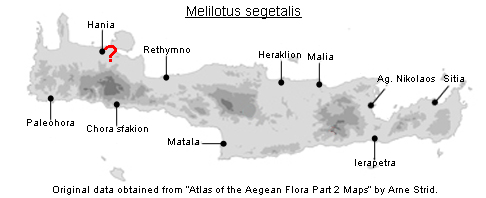
SPECIES DESCRIPTION
MELILOTUS SEGETALIS
Family and Genus:- See- LEGUMINOSAE
Common Names:- Corn melilot
Homotypic Synonyms:- None
Meaning:- Melilotus (Gr) Honey-clover. A name used by the Greek academic
Theophrastus and refers to melilot's attractiveness to honeybees.
Segetalis (L) Of cornfields, growing amongst crops. This epithet is
somewhat misleading; at least in Greece this is mainly a species of damp coastal
meadows.
General description:- Ascending to erect, glabrous annual.
Stems:-
1) 20-50 cm tall.
Leaves:-
1) Leaflets:
a) lower, broadly obovate.
b) upper, narrower,
c) both, finely but sharply serrate in the upper half.
2) Stipules, lanceolate with broad, somewhat dentate at the base.
Flowers:-
1) Peduncles, c. twice as long as the petiole of the subtending leaf.
2) Racemes, 2-3 cm, slender, 15-30-flowered, moderately elongating in fruit.
3) Corolla, 4-6 mm, yellow.
Fruit:-
1) Legume, 3-4 mm, shortly stipitate, obovoid, obtuse, somewhat compressed, with
conspicuous, dense, concentric raised veins, pale brown when ripe.
Key features:-
1) Corolla, 4-6 mm.
2) Legume, stipitate.
3) Leaflets, all finely but sharply serrate in the upper half.
Habitat:- Saline swamps, damp meadows, fallow fields and ruderal habitats. 0-400
m.
Distribution:- Coastal habitats of W. Greece. - Mediterranean region, mainly in the
W & C parts The Cretan record dates back to Heldreich and needs confirmation..
Flowering time:- Apr-May.
Photos by:- Kind permission of Saxifraga - Free Nature Images
